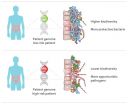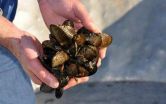(Press-News.org) HOUSTON -- (Dec. 16, 2014) -- In one of the most comprehensive laboratory studies of its kind, Rice University scientists traced the uptake and accumulation of quantum dot nanoparticles from water to plant roots, plant leaves and leaf-eating caterpillars.
The study, one of the first to examine how nanoparticles move through human-relevant food chains, found that nanoparticle accumulation in both plants and animals varied significantly depending upon the type of surface coating applied to the particles. The research is available online in the American Chemical Society's journal Environmental Science & Technology.
"With industrial use of nanoparticles on the rise, there are increasing questions about how they move through the environment and whether they may accumulate in high levels in plants and animals that people eat," said study co-author Janet Braam, professor and chair of the Department of BioSciences at Rice.
Braam and colleagues studied the uptake of fluorescent quantum dots by Arabidopsis thaliana, an oft-studied plant species that is a relative of mustard, broccoli and kale. In particular, the team looked at how various surface coatings affected how quantum dots moved from roots to leaves as well as how the particles accumulated in leaves. The team also studied how quantum dots behaved when caterpillars called cabbage loopers (Trichoplusia ni) fed upon plant leaves containing quantum dots.
"The impact of nanoparticle uptake on plants themselves and on the herbivores that feed upon them is an open question," said study first author Yeonjong Koo, a postdoctoral research associate in Braam's lab. "Very little work has been done in this area, especially in terrestrial plants, which are the cornerstone of human food webs."
Some toxins, like mercury and DDT, tend to accumulate in higher concentrations as they move up the food chain from plants to animals. It is unknown whether nanoparticles may also be subject to this process, known as biomagnification.
While there are hundreds of types of nanoparticles in use, Koo chose to study quantum dots, submicroscopic bits of semiconductors that glow brightly under ultraviolet light. The fluorescent particles -- which contained cadmium, selenium, zinc and sulfur -- could easily be measured and imaged in the tests. In addition, the team treated the surface of the quantum dots with three different polymer coatings -- one positively charged, one negatively charged and one neutral.
"In industrial applications, nanoparticles are often coated with a polymer to increase solubility, improve stability, enhance properties and for other reasons," said study co-author Pedro Alvarez, professor and chair of Rice's Department of Civil and Environmental Engineering. "We expect surface coatings to play a significant role in whether and how nanomaterials may accumulate in food webs."
Previous lab studies had suggested that the neutral coatings might cause the nanoparticles to aggregate and form clumps that were so large that they would not readily move from a plant's roots to its leaves. The experiments bore this out. Of the three particle types, only those with charged coatings moved readily through the plants, and only the negatively charged particles avoided clumping altogether. The study also found that the type of coating impacted the plants' ability to biodegrade, or break down, the quantum dots.
Koo and colleagues found caterpillars that fed on plants containing quantum dots gained less weight and grew more slowly than caterpillars that fed on untainted leaves. By examining the caterpillar's excrement, the scientists were also able to estimate whether cadmium, selenium and intact quantum dots might be accumulating in the animals. Again, the coating played an important role.
"Our tests were not specifically designed to measure bioaccumulation in caterpillars, but the data we collected suggest that particles with positively charged coatings may accumulate in cells and pose a risk of bioaccumulation," Koo said. "Based on our findings, more tests should be conducted to determine the extent of this risk under a broader set of ecological conditions."
INFORMATION:
The research was supported by the National Science Foundation. Additional co-authors include Jing Wang, Qingbo Zhang, Huiguang Zhu and Wassim Chehab, all of Rice, and Vicki Colvin of Brown University.
High-resolution IMAGES are available for download at:
http://news.rice.edu/wp-content/uploads/2014/12/1215_DOTS-plants-lg.jpg
CAPTION: The buildup of fluorescent quantum dots in the leaves of Arabidopsis plants is apparent in this photograph of the plants under ultraviolet light.
CREDIT: Y. Koo/Rice University
http://news.rice.edu/wp-content/uploads/2014/12/1215_DOTS-looper041-lg.jpg
CAPTION: Cabbage looper
CREDIT: Tommy LaVergne/Rice University
http://news.rice.edu/wp-content/uploads/2014/12/1215_DOTS-Yeonjong-43-lg.jpg
CAPTION: Yeonjong Koo
CREDIT: Jeff Fitlow/Rice University
http://news.rice.edu/wp-content/uploads/2014/05/0602_HHMI-Braam-lg.jpg
CAPTION: Janet Braam
CREDIT: Jeff Fitlow/Rice University
A copy of the Environmental Science & Technology paper is available at:
http://pubs.acs.org/doi/abs/10.1021/es5050562
Follow Rice News and Media Relations via Twitter @RiceUNews
Located on a 300-acre forested campus in Houston, Rice University is consistently ranked among the nation's top 20 universities by U.S. News & World Report. Rice has highly respected schools of Architecture, Business, Continuing Studies, Engineering, Humanities, Music, Natural Sciences and Social Sciences and is home to the Baker Institute for Public Policy. With 3,920 undergraduates and 2,567 graduate students, Rice's undergraduate student-to-faculty ratio is just over 6-to-1. Its residential college system builds close-knit communities and lifelong friendships, just one reason why Rice is highly ranked for best quality of life by the Princeton Review and for best value among private universities by Kiplinger's Personal Finance. To read "What they're saying about Rice," go here.
This news release is available in German. A research team at Bielefeld University has succeeded in teaching the only robot of its kind in the world how to walk. Its first steps have been recorded in a video. You can watch them in Bielefeld University's latest posting on 'research_tv'. The robot is called Hector, and its construction is modelled on a stick insect. Inspired by the insect, Hector has passive elastic joints and an ultralight exoskeleton. What makes it unique is that it is also equipped with a great number of sensors and it functions according to a biologically ...
DURHAM, N.C. - Duke University scientists have developed new forensic tracers to identify coal ash contamination in water and distinguish it from contamination coming from other sources.
"These new tools can be used by federal and state regulatory agencies to monitor the environmental effects of coal ash and determine whether it has or hasn't impacted the environment," said Avner Vengosh, professor of geochemistry and water quality at Duke's Nicholas School of the Environment. "They can be used to trace the coal ash effluents to their source, even in watersheds where ...
Washington, D.C.--New work from Carnegie's Ivan Naumov and Russell Hemley delves into the chemistry underlying some surprising recent observations about hydrogen, and reveals remarkable parallels between hydrogen and graphene under extreme pressures. Their work is the cover story in the December issue of Accounts of Chemical Research.
Hydrogen is the most-abundant element in the cosmos. With only a single electron per atom, it is deceptively simple. As a result, hydrogen has been a testing ground for theories of the chemical bond since the birth of quantum mechanics ...
MINNEAPOLIS/ST. PAUL (12/16/2014)--A new study by an international team of researchers shows for the first time that people may inherit some of the intestinal bacteria that cause Crohn's disease and ulcerative colitis, collectively know as inflammatory bowel disease (IBD). The study, recently published in Genome Medicine, also confirmed that antibiotics could worsen the imbalance in the gut microbes.
About 1.6 million Americans suffer from Crohn's disease or ulcerative colitis, according to the Crohn's and Colitis Foundation of America. Understanding the causes of these ...
AMHERST, Mass. - In a follow-up to her earlier studies of learning in infancy, developmental psychologist Lisa Scott and colleagues at the University of Massachusetts Amherst are reporting that talking to babies in their first year, in particular naming things in their world, can help them make connections between what they see and hear, and these learning benefits can be seen as much as five years later.
"Learning in infancy between the ages of six to nine months lays a foundation for learning later in childhood," Scott says. "Infants learn labels for people and things ...
WASHINGTON, DC--December 16, 2014--Using mathematical modeling, researchers at New York and Vanderbilt universities have shown that commensal bacteria that cause problems later in life most likely played a key role in stabilizing early human populations. The finding, published in mBio®, the online open-access journal of the American Society for Microbiology, offers an explanation as to why humans co-evolved with microbes that can cause or contribute to cancer, inflammation, and degenerative diseases of aging.
The work sprung from a fundamental question in biology ...
INDIANAPOLIS -- In the first real-world trial of the impact of patient-controlled access to electronic medical records, almost half of the patients who participated withheld clinically sensitive information in their medical record from some or all of their health care providers.
Should patients control who can see specific information in their electronic medical records? How much control should they have? Can doctors and other clinicians provide safe, high-quality care when a patient's preference may deny members of the medical team from seeing portions of the electronic ...
BALTIMORE, MD (Dec. 16, 2014)--With a unique, multi-faceted approach, researchers at the Lieber Institute for Brain Development (LIBD) have quantified the effect of previously unidentified anomalies in genetic expression that determine how the human brain develops from its earliest stages. Their work, published online December 15th in Nature Neuroscience, offers a novel technique for identifying biological markers in brain development that associate with risk for neurodevelopmental disorders such as schizophrenia and autism spectrum disorder (ASD).
Using state-of-the-art ...
The mortality of larval Pacific oysters in Northwest hatcheries has been linked to ocean acidification. Yet the rate of increase in carbon dioxide in the atmosphere and the decrease of pH in near-shore waters have been questioned as being severe enough to cause the die-offs.
Now, a new study of Pacific oyster and Mediterranean mussel larvae found that the earliest larval stages are sensitive to saturation state, rather than carbon dioxide (CO2) or pH (acidity) per se.
Saturation state is a measure of how corrosive seawater is to the calcium carbonate shells made by ...
Being "average" is often considered a bad thing, but new research suggests that averageness wins when people assess the trustworthiness of a face. The research indicates that, while typical-looking faces aren't seen as the most attractive, they are considered to be the most trustworthy. The new findings are published in Psychological Science, a journal of the Association for Psychological Science.
"Face typicality likely indicates familiarity and cultural affiliation - as such, these findings have important implications for understanding social perception, including cross-cultural ...







